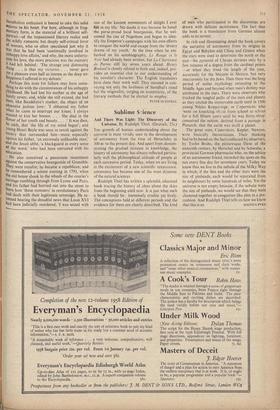Sublime Science
And. There Was Light: The Discovery of the Universe. By Rudolph Thiel. (Deutsch, 25s.) THE growth of human understanding about the universe is most vividly seen in the development of astronomy from the time of Heraclides in 300 BC to the present day. And apart from demon- strating the gradual increase in knowledge, the history of astronomy has always reflected particu- larly well the philosophical attitude of people at each successive period. Today, when we are living in the excitement of a new scientific renaissance, astronomy has become one of the most dynamic of the natural sciences.
Rudolph Thiel has written a splendid, educated book tracing the history of ideas about the skies from the beginning until now. It is just what such a book should be : immensely erudite yet lively. The conceptions held at different periods and the evidence for them are clearly described. The kind of men who participated in the discoveries are drawn with delicate incisiveness, The fact that the book is a translation from German almost adds to its savour.
In rich and illuminating detail the book, covers the narrative of astronomy from its origins in Egypt and Babylon and China and Greece when the stars were used to determine the north or the east—the pyramid of Cheops deviates only by a few minutes of a degree .from the cardinal points —or when they fixed the length of the year, accurately for the Mayans in Mexico, but very inaccurately for the Jews. Then there was the long period of stellar mythology extending to the Middle Ages and beyond when man's destiny was attributed to the stars. There were observers whio tracked the tangled paths of the stars and planets as they circled the immovable earth until in 1500 young Niklas Koppernigk, or Copernicus, who 'went on knocking abcdit from .school to school for a full fifteen years until he was thirty-three' conceived the notion, derived from a passage in Plutarch, that the earth was itself a planet.
The great men, Copernicus. Kepler, Newton, were basically theoreticians. Their thinking had to be.based on the facts collected by observers, by Tycho Brahe, the picturesque Dane of the sixteenth century, by Herschel and by Schwabe, a provincial German pharmacist who, on the advice of an astronomer friend, recorded the spots on the sun every fine day for seventeen years:Today we know that we live in the nebula of the Milky Way in which, if the Sun and the other stars were the size of pinheads, each would be separated from its neighbours by some hundreds of miles. Yet the universe is not empty because, if the nebula: were the size of pinheads, ,we would see that they were clustered together in congestion like pins in a pin- cushion. And Rudolph Thiel tells us how we know














































































 Previous page
Previous page